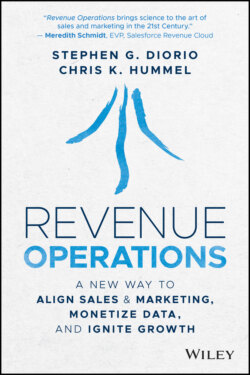Читать книгу Revenue Operations - Stephen Diorio, Chris K. Hummel - Страница 25
The Role of Leadership
ОглавлениеThe leadership model for managing growth resources is similarly outdated. For example, the Chief Marketing Officer (CMO) is a job function built on big brands and TV budgets that has only existed for a few short decades. But those big media budgets have been in decline for years. This has left many CMOs struggling to find a seat at the table as their core budgets have eroded and fighting from being pigeonholed at the very front of the revenue cycle. Large field sales organizations like the famous IBM “Blue Suits” have been around a long time, but the selling function has evolved by adding multiple tele, social, web, and even contactless channels that don't necessarily need a field sales force to serve customers. Service has become far more elevated and strategic as product adoption and experience have become central to customer relationship building, revenue expansion, and customer lifetime value.
Today, the functional distinctions between marketing, sales, and service exist more because of cultural and operational inertia rather than market reality. The silos that manage these roles have become a political and operational necessity to keep the machine running and cash flowing in the short term. These silos have also led to dysfunction and waste. Strategically, the hard functional structures represent a boat anchor that holds back revenue growth in the twenty-first century by impeding horizontal information flow across the revenue cycle and by making it difficult to deploy technology as a force multiplier at scale.
The twentieth century commercial structure is collapsing under the twin pressures of changing customer behavior and shifting business models. “Organizations are going to need to rewire their commercial engines to better reflect the new buying reality where customers are channel agnostic and buyer behavior is non-linear,” reports Brent Adamson, distinguished Vice President in Gartner's Sales practice.129 “It's a big job. It's going to involve reworking the legacy commercial infrastructure, and creating new roles, processes and metrics.”
Thus, it's no surprise that the vast majority of the senior growth leaders we spoke to in writing this book were taking steps to better align sales, marketing, and service teams to sustain and accelerate growth in light of the forces and dynamics we have outlined here. Over 90% were actively redefining the way they “architect” their selling channels and consolidating the operations that support selling and oversee customer data and technology assets. Eighty-five percent of CXOs were actively reconfiguring the roles and assignments on their revenue teams to improve the customer experience and grow the value of their accounts. And over 9,000 businesses have introduced “CXO” roles with a broader span of control over sales and marketing and a CEO mandate to lead commercial operations, systems, and processes across the entire business. Most significantly, almost all of them – regardless of company size or the industry they serve – believe fixing the commercial model in light of these market trends requires leadership from the CEO to succeed and a common purpose across every employee that touches the customer.
The CXOs we spoke with are also working to find ways to generate greater returns from the systems and technologies that support selling. Most feel their investments in CRM, digital selling infrastructure, sales enablement technology, and data assets are underperforming. They feel like they are working increasingly harder at the care and feeding of these tools, rather than the tools working harder for them. They feel their sales and marketing technology stacks have become too complicated. The majority tell us they are trying to rationalize, simplify, and better connect the many solutions in their sales technology stack. They are doing this to simplify the seller workflow, better leverage customer insights in day-to-day selling, and turn technology into a “force multiplier” to help them sell more for less.
This shift in focus is happening across businesses large and small, in every industry. Executives we spoke with agree on the importance of Revenue Operations, even if – until now – there has been little clarity on an exact definition or description of this still-maturing discipline. This book intends to change that.
